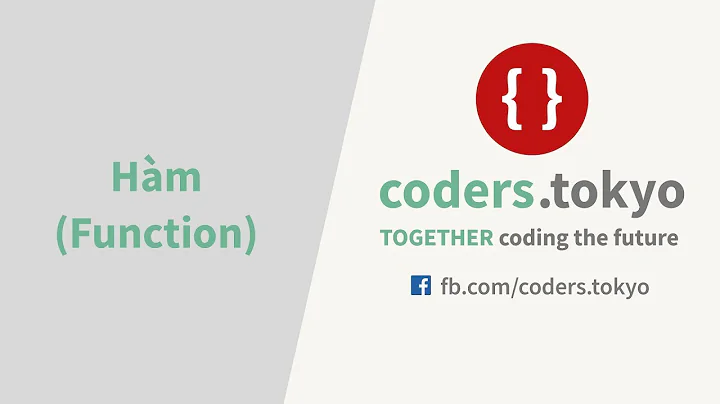What is "function*" in JavaScript?
Solution 1
It's a Generator function.
Generators are functions which can be exited and later re-entered. Their context (variable bindings) will be saved across re-entrances.
Calling a generator function does not execute its body immediately; an iterator object for the function is returned instead. When the iterator's
next()method is called, the generator function's body is executed until the firstyieldexpression, which specifies the value to be returned from the iterator or, withyield*, delegates to another generator function.
Historical note:
It's a proposed syntax for EcmaScript.next.
Dave Herman of Mozilla gave a talk about EcmaScript.next. At 30:15 he talks about generators.
Earlier, he explains how Mozilla is experimentally implementing proposed language changes to help steer the committee. Dave works closely with Brendan Eich, Mozilla's CTO (I think), and the original JavaScript designer.
You can find more detail on the EcmaScript working group wiki: http://wiki.ecmascript.org/doku.php?id=harmony:generators
The working group (TC-39) has general agreement that EcmaScript.next should have some kind of generator iterator proposal, but this is not final.
You shouldn't rely on this showing up without changes in the next version of the language, and even if it doesn't change, it probably won't show up widely in other browsers for a while.
Overview
First-class coroutines, represented as objects encapsulating suspended execution contexts (i.e., function activations). Prior art: Python, Icon, Lua, Scheme, Smalltalk.
Examples
The “infinite” sequence of Fibonacci numbers (notwithstanding behavior around 253):
function* fibonacci() { let [prev, curr] = [0, 1]; for (;;) { [prev, curr] = [curr, prev + curr]; yield curr; } }Generators can be iterated over in loops:
for (n of fibonacci()) { // truncate the sequence at 1000 if (n > 1000) break; print(n); }Generators are iterators:
let seq = fibonacci(); print(seq.next()); // 1 print(seq.next()); // 2 print(seq.next()); // 3 print(seq.next()); // 5 print(seq.next()); // 8
Solution 2
It's a generator function - and it said so in the page you cite, in the comment you replaced with "this is the interesting line"...
Basically it's a way to specify sequences programmatically so that they can be passed around and elements accessed by index without having to compute the entire sequence (possibly infinite in size) beforehand.
Solution 3
The function* type looks like it acts as a generator function for processes that can be iterated.
C# has a feature like this using "yield return" see 1 and see 2
Essentially this returns each value one by one to whatever is iterating this function, which is why their use case shows it in a foreach style loop.
Related videos on Youtube
string QNA
Updated on September 04, 2021Comments
-
string QNA almost 3 years
In this page I found a new JavaScript function type:
// NOTE: "function*" is not supported yet in Firefox. // Remove the asterisk in order for this code to work in Firefox 13 function* fibonacci() { // !!! this is the interesting line !!! let [prev, curr] = [0, 1]; for (;;) { [prev, curr] = [curr, prev + curr]; yield curr; } }I already know what
yield,letand[?,?]=[?,?]do, but have no idea what thefunction*is meant to be. What is it?P.S. don't bother trying Google, it's impossible to search for expressions with asterisks (they're used as placeholders).
-
Solomon Duskis almost 10 yearsThe comment in the example is quite old now,
function*syntax is supported in Firefox since v26: developer.mozilla.org/en-US/docs/Web/JavaScript/Reference/…* . Older versions used a different syntax. -
trysis over 9 yearsRegarding Google, just search for "function star" or "function asterisk". That's how I found this question ;).
-
 ruffin about 9 yearsLooks like the
ruffin about 9 yearsLooks like the*was stripped from the link from @Nickolay. Here's a link directly tofunction*at MDN. Sure enough, "basic" support since v26. -
 BlueRaja - Danny Pflughoeft over 8 yearsAnother MDN link (which, by the way, I found on the MDN page linked by OP): developer.mozilla.org/en-US/docs/Web/JavaScript/Reference/…
BlueRaja - Danny Pflughoeft over 8 yearsAnother MDN link (which, by the way, I found on the MDN page linked by OP): developer.mozilla.org/en-US/docs/Web/JavaScript/Reference/… -
Logan about 7 yearsAnother useful MDN link: developer.mozilla.org/en-US/docs/Web/JavaScript/Reference/…*
-
Eats Indigo about 6 yearsOn the note of searching for this question, there's a search engine called symbolhound that includes special characters in your searches
-
 mekb almost 5 yearsCheck this gist out, it should explain it.
mekb almost 5 yearsCheck this gist out, it should explain it.
-
-
Fergie almost 11 yearsFollow up: what does a for loop with no parameters (
for(;;)) do? Why use it in this context? -
Mike Samuel almost 11 years@Fergie,
for(;;)is the same aswhile (true). It's used in this context since the Fibonacci sequence is an unbounded sequence. -
Mike Samuel over 9 years@DaveVandenEynde, prior prior art: Python yield. Prior prior prior art: CLU and Icon.
-
wes almost 9 years"accessed by index without having to compute the entire sequence" is possibly the most helpful bit of explanation about generators I've come across so far. I could see using this in an app, vs previously just understanding it theoretically.









